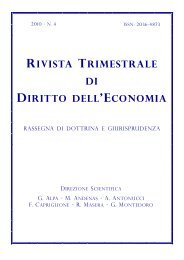rivista trimestrale di diritto dell 'economia - Fondazione Capriglione ...
rivista trimestrale di diritto dell 'economia - Fondazione Capriglione ...
rivista trimestrale di diritto dell 'economia - Fondazione Capriglione ...
Create successful ePaper yourself
Turn your PDF publications into a flip-book with our unique Google optimized e-Paper software.
EUROSCLEROSI E GLOBALIZZAZIONE.<br />
(CONTRO UN POSSIBILE RITORNO ALL’EUROSCETTICISMO)*<br />
ABSTRACT: The term “Eurosclerosis”- used since the 1980s to describe the state of European<br />
economic malaise in comparison to the U.S. economy - today takes on a meaning<br />
symptomatic of the “severe crisis” now threatening the Old World. An analysis of how<br />
public authorities have intervened in several countries by adopting anti-crisis measures<br />
highlights the regional context of their intervention. It has become evident that the legaleconomic<br />
convergence that formed the basis of the construction of the European Union,<br />
has not resulted in the creation of “a concept of solidarity” amongst EU Member States.<br />
Europe – heavily tested by the “Greek pre<strong>di</strong>cament” and its resulting implications for the<br />
maintenance of adequate levels of supranational cohesion – highlights the possibility of a<br />
return to Euroscepticism, and the possibility of a trend of <strong>di</strong>strust for the “technical<br />
structure” upon which the EU is based. In this context, it appears particularly relevant<br />
the German Constitutional Court’s opposition to any transformation of the European<br />
Community into a 'political union'; while, on the other hand, the memory of certain failures<br />
in the past (most notably the failure of the unified Latin American currency) fuels<br />
concerns. The undeniable advantages of adopting a single currency, however, shall suggest<br />
not to lose the guarantees that the Euro is able to offer, the need to rethink the entire<br />
structural operation of the European Union, to leave behind the logic of compromise,<br />
and to renounce possible hegemonic trends in order to rewrite rules which would express<br />
a renewed “willingness to be united”, conducive to achieving an actual cohesion in the<br />
organizational structure of European institutions.<br />
SOMMARIO: 1. Premessa. - 2. La crisi e gli interventi a sostegno <strong>dell</strong>a economia. - 3. Situazione<br />
post-crisi: globalizzazione e limiti <strong>dell</strong>’Eurosistema. - 4. Il «caso Grecia» e le sue implicazioni a<br />
livello regionale europeo. - 5. L’ipotesi <strong>di</strong> un «Fondo monetario per l’Europa». - 6. Il possibile ritorno<br />
all’euroscetticismo (i.e. lo spettro <strong>dell</strong>’Unione monetaria latina). - 7. Ripensare le regole<br />
<strong>dell</strong>’Unione europea in una rinnovata logica <strong>di</strong> responsabilità.<br />
Haec tempora quibus nec vitia nostra, nec reme<strong>di</strong>a pati possumus<br />
(T. LIVIO, Storia <strong>di</strong> Roma, prefazione, paragr. n. 9)<br />
1. È nella metà degli anni ottanta del novecento - allorquando<br />
la Comunità europea, dopo la crisi economica del decennio precedente,<br />
viene a trovarsi in una fase <strong>di</strong> stallo nella costruzione del<br />
mercato interno - che si fa ricorso per la prima volta al termine<br />
eurosclerosi per in<strong>di</strong>care le <strong>di</strong>fficoltà ed il clima d’incertezze in<br />
cui versa l’Europa rispetto agli altri paesi <strong>dell</strong>’area Ocse 1 .<br />
(*) Il presente saggio è destinato agli «Scritti in onore <strong>di</strong> Marcello Foschini»<br />
1 Ed invero il tasso <strong>dell</strong>'inflazione (6 per cento) e quello <strong>di</strong> <strong>di</strong>soccupazione (11 per cento)<br />
risultano assai più alti che altrove; nel 1984 la crescita del red<strong>di</strong>to si attesta al 2,4 per<br />
cento rispetto a tre volte tanto negli Stati Uniti ed al doppio nel Giappone, cfr. FONDO<br />
MONETARIO INTERNAZIONALE, World Economic Outlook, October 1985, Washington, pag.<br />
2 (Table 1).




